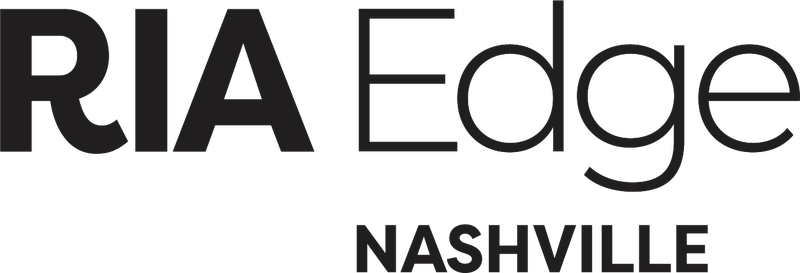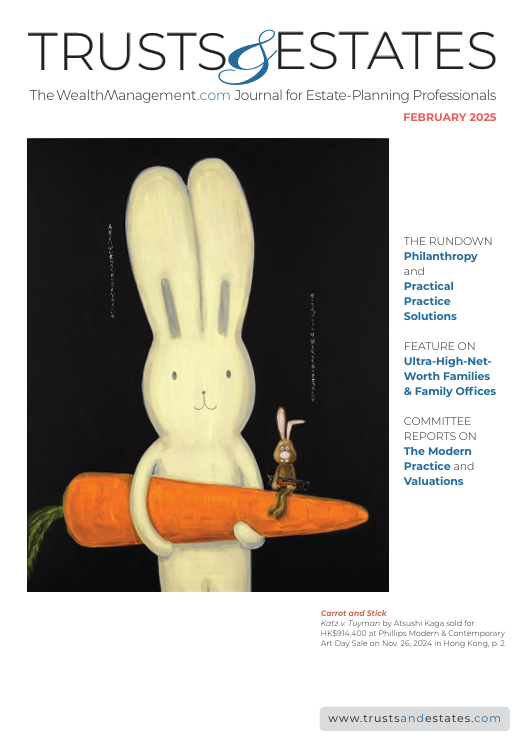Unlocking the Potential of Carried Interest in Estate PlanningUnlocking the Potential of Carried Interest in Estate Planning
The right estate planning approach can result in a significant, tax-efficient transfer of your client’s wealth.

As we start 2025, advisors must guide clients through the intricacies of tax and estate planning strategies. For highly compensated clients who manage private equity, venture capital and hedge funds, this means taking advantage of the unique characteristics of carried interest, including its timing, risk and illiquidity. More on that in a minute.
Plan Today, Save Tomorrow
The current federal estate and gift tax exemptions will remain historically high for at least one more year, creating a rare opportunity for estate planning. For 2025, individuals can transfer up to $13.99 million for individuals and $27.98 million for married couples.
However, these elevated exemptions are set to sunset on Dec. 31, 2025. Starting in 2026, the exemptions are scheduled to revert to pre-2018 levels, estimated to be approximately $7 million for individuals and $14 million for married couples. While some may hope for political action to maintain the higher exemptions, maximizing the current opportunities before they likely diminish is prudent. As the old saying goes: “hope is not a strategy.”
Assets With High Appreciation Potential
A cornerstone of good estate planning is transferring assets out of a taxable estate early if they’re expected to appreciate significantly in value. This includes carried interest. By removing these assets early, families can minimize estate taxes on the appreciation of those assets while preserving more wealth for beneficiaries. At a fund’s inception, carry is speculative and holds minimal value because it depends entirely on future fund performance. However, as the fund matures and its investments perform, the carry’s value can increase dramatically. By transferring carry early, the subsequent appreciation occurs outside the taxable estate, avoiding significant estate taxes.
Carried Interest: What’s it Worth?
Valuing carried interest for estate planning requires us to address its contingent nature and dependence on fund performance. While the option pricing model offers a theoretical approach, it often falls short in practical applications. OPM calculations focus on volatility, expected returns and time to realization. However, these generalities overlook the nuances of fund structures, such as distribution waterfalls and the timing of exits. As a result, OPM valuations can appear inflated and less defensible under Internal Revenue Service scrutiny.
The discounted cash flow method is far more reliable for valuing carried interest. DCF modeling ties valuation directly to fund-specific cash flows, offering a clear picture of the timing, amount and risk associated with carry payments. DCF incorporates critical factors such as projected exit timing, fund distribution waterfalls and high discount rates to account for the inherent risks and illiquidity of carry. DCF ensures a more realistic and defensible valuation that aligns with IRS expectations and minimizes risks of challenge.
Illiquidity Equals Opportunity
A critical factor in valuing carried interest is addressing its illiquidity, which can significantly reduce its market value. The Discount for Lack of Marketability accounts for this illiquidity and is essential for creating an accurate and defensible valuation. While it’s common to rely on broad benchmarks derived from restricted stock or pre-IPO studies, such averages often fail to capture the unique characteristics of the specific interest being valued. Generalized approaches may overlook crucial nuances, resulting in over- or under-valuation. DLOM can range from 25% to 35% or higher for carried interest.
A more nuanced approach to DLOM focuses on tailoring the discount to the specific risks and constraints associated with the subject interest. For carried interest, these risks include the contingent nature of distributions, the lack of an active market, and extended holding periods. Simply applying averages ignores the aforementioned risks and may leave valuations vulnerable to scrutiny. Instead, integrating empirical data as a starting point and then layering adjustments for fund-specific risks produces a more precise and defensible result.
This tailored method strengthens the credibility of the valuation by addressing both theoretical and practical risks inherent in carried interest. It also mitigates potential IRS challenges by demonstrating a thorough and individualized analysis. By moving beyond simple benchmarks, advisors can ensure that DLOM calculations reflect the true marketability constraints and risk profile of the interest, resulting in a valuation that is both accurate and robust.
Theory in Action
The advantage of transferring carried interest early lies in allowing appreciation to occur outside the taxable estate. By acting sooner, clients secure a lower taxable value and shift future growth to beneficiaries.
Consider a private equity fund distributing $100 in carried interest in years 7 and 8. Transferring this interest in year 6, when the fund is mature and risks are lower, results in a valuation reflecting this certainty. Using a 12.5% discount rate, the present value (PV) of the distributions totals $167.90. After applying a 20% discount for lack of marketability (DLOM), the valuation drops to $134.32.
Now compare this to a transfer at the fund’s inception, in year 0. At this speculative stage, unresolved risks around investment performance and exits justify a higher discount rate of 27.5%, reducing the PV to $59.09. Applying a 30% DLOM, the valuation falls further to $41.36.
The difference is clear: transferring carried interest at inception results in a taxable gift valued at $41.36, compared to $134.32 in year 6. This strategy shifts a low-value, high-growth asset out of the estate, minimizing tax exposure and maximizing wealth preservation for beneficiaries. Timing isn’t just a factor in estate planning—it’s the opportunity itself.
Navigating IRC Section 2701
Internal Revenue Code Section 2701 addresses abuses in transferring interests in closely held entities. It requires transfers to include all ownership components, preventing fund managers from isolating speculative, high-growth carried interest while retaining stable, lower-risk assets. The “Vertical Slice Rule” serves as a safe harbor under IRC Section 2701, mandating that any transfer of carried interest must include a proportional share of the general partner’s (GP’s) capital interest. This ensures that transfers reflect the overall economic reality of fund ownership rather than selectively gifting high-growth interests.
For example, if a GP holds a 20% carried interest and a 1% capital interest, transferring 50% of the carry requires the GP to transfer 50% of the capital interest as well. While this proportionality protects against undervaluation, it reduces the effectiveness of the gift since capital interests typically have lower appreciation potential.
To overcome this dilution, estate planners may use derivatives to separate the economic benefits of carried interest from its ownership. These agreements bypass the Vertical Slice Rule, allowing the transfer of high-growth potential carry without including less efficient capital interests. This strategy optimizes the tax-efficient transfer of wealth while maintaining compliance with Section 2701.
Carried Interest Derivatives
Carried interest derivatives are a compelling alternative for estate planning, particularly when navigating the complexities of IRC Section 2701 and trying to maximize the effectiveness of the gift. These instruments allow clients to transfer the economic benefits of carry without transferring the interest itself. A derivative agreement typically involves the GP allocating a portion of future carry distributions to a trust or beneficiary. This structure separates ownership from economic rights, enabling efficient wealth transfer while avoiding proportional transfer requirements.
For example, a derivative agreement might specify that 50% of future carry distributions be allocated to a trust. The agreement’s value reflects the present value of these future payments, incorporating appropriate discounts for risks and illiquidity. This approach offers flexibility and ensures compliance with IRS standards, making it an effective tool for high-net-worth individuals seeking to transfer significant wealth while minimizing tax exposure.
The Right Approach
When it comes to carried interest, the right estate planning approach can result in a significant, tax-efficient transfer of your client’s wealth. By leveraging assets with high appreciation potential, using the DCF method to establish defensible valuations, incorporating a robust two-stage DLOM to address marketability constraints, and by exploring derivatives to address regulatory hurdles, advisors can help clients preserve their legacies while minimizing estate tax liabilities. With elevated exemptions set to decline after 2025, taking advantage of these strategies now ensures clients can secure their financial future for generations to come.
Anthony Venette, CPA/ABV, is a Senior Manager in Business Valuation & Advisory at DeJoy & Co., based in Rochester, NY. He advises corporate and individual clients on cash flow management, tax planning, and strategic estate and business valuation, bringing his expertise to optimize outcomes for clients navigating complex financial landscapes.
About the Author
You May Also Like





